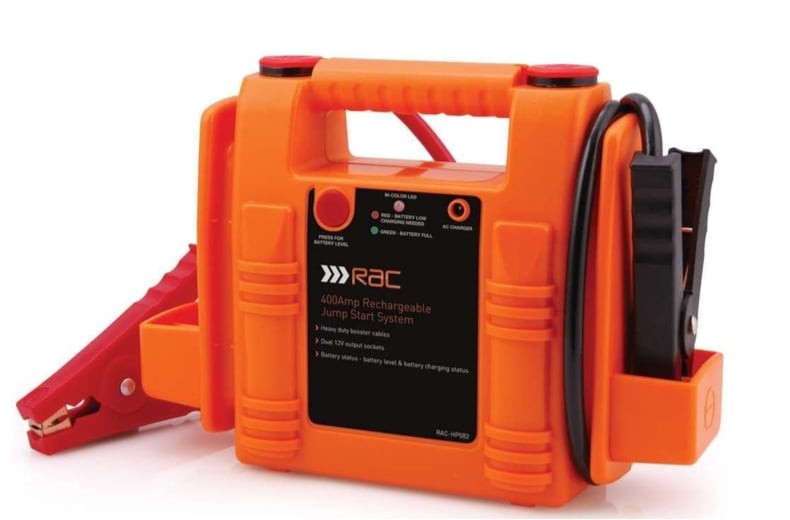Getting stuck with a dead car battery can be a frustrating experience, especially when you are in a hurry or in a remote location. Fortunately, portable jump starters offer a convenient solution, allowing you to revive your car without needing another vehicle. This guide will walk you through the steps on how to safely and effectively jump start your car using a portable battery pack.
 Using a portable jump starter to revive a dead car battery. Red and black clamps are connected to the battery terminals.
Using a portable jump starter to revive a dead car battery. Red and black clamps are connected to the battery terminals.
Before you begin, safety should be your top priority. Incorrect jump starting procedures can damage your vehicle or cause personal injury. Always consult your car’s owner manual for specific instructions and safety guidelines related to jump starting. If you are uncertain about any step, it’s always best to seek professional assistance.
Essential Preparations
Before you attempt to jump start your car, make sure you have the necessary equipment and take a few crucial safety precautions:
- Portable Jump Starter: Ensure your portable jump starter is fully charged. Check the manufacturer’s instructions for charging and usage guidelines.
- Safety Check: Inspect both your car battery and the jump starter for any visible damage, such as cracks or leaks. Do not proceed if there is any damage. Also, check the jump leads for any frayed wires or damaged clamps.
- Remove Metal Jewelry: Take off any rings, watches, or other metal jewelry that could potentially come into contact with the battery terminals, as this can cause a short circuit and injury.
Step-by-Step Guide to Jump Starting
Once you’ve prepared and taken the necessary safety measures, follow these steps to jump start your car using a portable battery pack:
-
Locate Your Car Battery: In most vehicles, the battery is located under the hood in the engine bay. However, in some models, it might be situated in the trunk or under the back seat. Refer to your owner’s manual if you’re unsure of its location. Often, the battery will be under a plastic cover that you can easily unclip to access the terminals.
-
Identify Battery Terminals: You’ll see two terminals on your car battery, marked positive (+) and negative (-). The positive terminal is usually red and may have a plus sign, while the negative terminal is typically black with a minus sign.
-
Connect Positive Lead: Take the red clamp from your portable jump starter and firmly attach it to the positive (+) terminal of your car battery.
-
Connect Negative Lead: Next, take the black clamp from the jump starter and connect it to a suitable grounding point on your car. Do not connect it directly to the negative (-) battery terminal. A good grounding point is a solid, unpainted metal part of the engine block or chassis, away from the battery and fuel lines. This helps to minimize the risk of sparks near the battery.
-
Position the Jump Starter: Place the portable jump starter on a stable surface on the ground, near your vehicle. Ensure the leads are long enough and avoid placing it directly on the engine, where it could fall off due to vibrations once the engine starts.
-
Turn on the Jump Starter: Switch on the portable jump starter according to the manufacturer’s instructions.
-
Start Your Car: Attempt to start your car as you normally would. If the car doesn’t start after a few tries, there might be a more serious issue than just a dead battery. In this case, it’s advisable to seek professional help from a mechanic or roadside assistance service.
-
Let the Engine Run: If your car starts successfully, let the engine run for about 5-10 minutes. This will allow the alternator to begin recharging your car battery.
-
Turn Off and Disconnect: Turn off your car engine, then switch off the portable jump starter. Carefully disconnect the black clamp first, followed by the red clamp, in reverse order of connection.
-
Restart Your Car: Try restarting your car again to ensure the battery has enough charge to start on its own.
After Jump Starting
Jump starting provides a temporary solution to get your car running again. However, it’s crucial to address the underlying issue of why your battery died in the first place.
- Recharge Your Battery: Driving your car for about 30 minutes at normal speeds can help recharge the battery to some extent. However, for a full and proper recharge, it’s best to use a dedicated car battery charger for several hours.
- Battery Health Check: Consider getting your car battery tested by a professional mechanic to determine its condition and whether it needs replacement. A dead battery might be a sign of an aging battery or an issue with your car’s charging system.
Having a portable jump starter is a valuable tool for any car owner, providing peace of mind and a solution for unexpected dead battery situations. By following these steps and prioritizing safety, you can confidently jump start your car and get back on the road.
